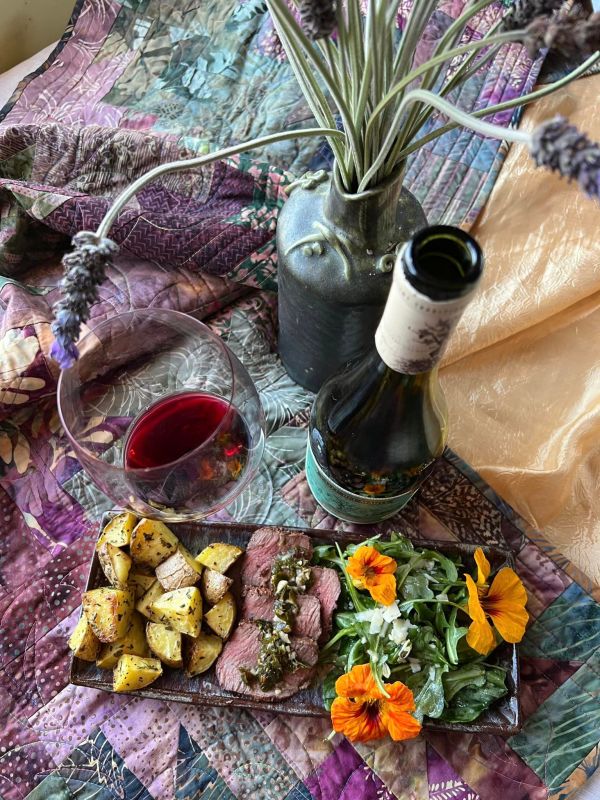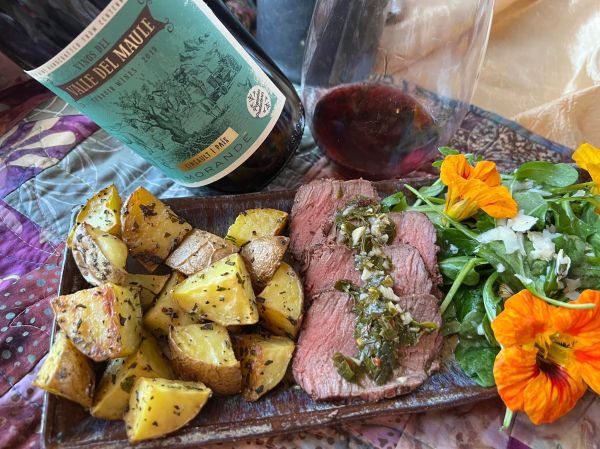Pais means country in Spanish, and in Chile, it also signifies a rustic red grape. Ampelographers believe Pais the grape, along with the Criolla Grande grape of Argentina and the Mission grape of California, are descended from the “common black grape” brought to Mexico in 1520 by the Spanish conquistador Hernán Cortés. Along with Spanish missionaries, the grape spread throughout the Americas; my grandfather planted the Mission grape in his yard in the Mission town of San BuenaVentura hoping to make wine from it. In Chile, the Pais grape was an important wine grape until the late 20th and early 21st centuries when Bordeaux wine varietals like Cabernet Sauvignon became more prominent. In the 1940s, Cinsault brought color and structure to wines made with País.
In Chile’s Maule Valley, the cinsault vines in the Morande Pais Cinsault blend are head pruned and considered organically farmed. Located in an area of gentle, rolling hills in the Coastal Range, the vines receive very low rainfall, and the warm summer days are only slightly mitigated by coastal breezes. Cinsault, known locally as “cargadora” and país, also known as “chilena” or “huasa” resist drought and fungal diseases.
One of Chile’s most extensive valleys, Maule also has the largest production of wine grapes. Using similar techniques inherited from the Spanish Conquistadors like dry farming, low density, and head training, the Secano Interior sector has many old País and Carignan vineyards growing in the granitic, red clay soils.
The grapes had partial carbonic maceration fermentation combines with traditional fermentation with at least 25% complete berries in 2,000-liter concrete eggs and in open wooden tanks with natural yeasts. Some wine was stored in cement eggs and the rest racked directly into 300-liter French oak barrels for 10-month aging.
Menu for a Pais-Cinsault Blend from Chile
- herb roasted potatoes
- arugula salad with parmesan cheese and lemon dressing
- filet mignon with Chilean Chimichurri
2019 Morande Vinos Del Valle Del Maule
ABV: 13%
SRP: under $15
Grapes: 75% Cinsault, 25% Pais
sample for my review
Appearance: Ruby, fushia rim, very nice bright color, a bit cloudy
Aroma: Fruit that’s fresh including plum, cranberry, raspberry, black and red pepper, cinnamon, violets, damp earth, forest floor, musty, damp leaves.
Palate: Big bold tannins, very dry, sweet tart fruit, very bold, cherry, cranberry, raspberry, very warming on the palate, mint on the finish, nicely balanced considering how big and bold the tannins are.
Pairing: The structure and the tannins are completely tamed when this wine is paired with intensely flavored foods. The chimichuri was such a perfect companion with the grilled filet mignon topped with chimichuri sauce. The herbs on the oven roasted potatoes were also a beautiful companion to the wine. The herbs and garlic in the chimichuri sauce bring this big bold tannic wine to a completely different wine. It becomes smooth and has much more ripe fruit. Great with the salty Parmesan cheese in the arugula salad. Nice with the big bold peppery arugula. The salad stands up to the wine and the wine becomes mellower with the salad. The lemon, and the peppery notes are enhanced in the salad as well. We felt that anchovy filets would be a great addition to the salad when pairing with this wine.
For more, check out:
- A Chilean Seafood Soup and a Migrated Vine: Paila Marina + the 2019 Roberto Henríquez Tierra de Pumas by Culinary Cam
- Californio Enchiladas with a Chilean Chardonnay by A Day in the Life on the Farm
- To Taste Tradition, Try Morande’s Organic Cinsault-Pais Blend Paired with Chilean Chimichurri Filet Mignon by Wine Predator…Gwendolyn Alley
- Wine Origins, the Mission Grape in the USA by Avvinare
You’re also invited to join our Twitter chat about the first Vitis vinifera grape variety to be exported from the Old World to the New Sat. 5/27 8am Pacific. Join the conversation via #WorldWineTravel. Here’s the preview from host @Culinary_Cam.




I”m glad you were able to source a bottle of wine. Interesting tidbit about your grandfather. Thanks for sharing.
LikeLiked by 1 person
Thank you for reminding me to link to a piece that I wrote about my grandfather’s cellar!
LikeLike
Thanks for joining us. I can’t wait to try that chimichurri-topped Filet Mignon. And how did your grandfather’s grape fare? Did he actually make wine with it?
LikeLiked by 1 person
Thanks for hosting! Such an interesting wine, actually. My grandfather always wanted to but he never actually did make wine. I found books and even a hand typed mimeographed booklet in his things when he died that I now have. The vines were prolific but never produced much in the way of grapes. We could have made elderberry cordial though! I didn’t know about that back then.
LikeLike